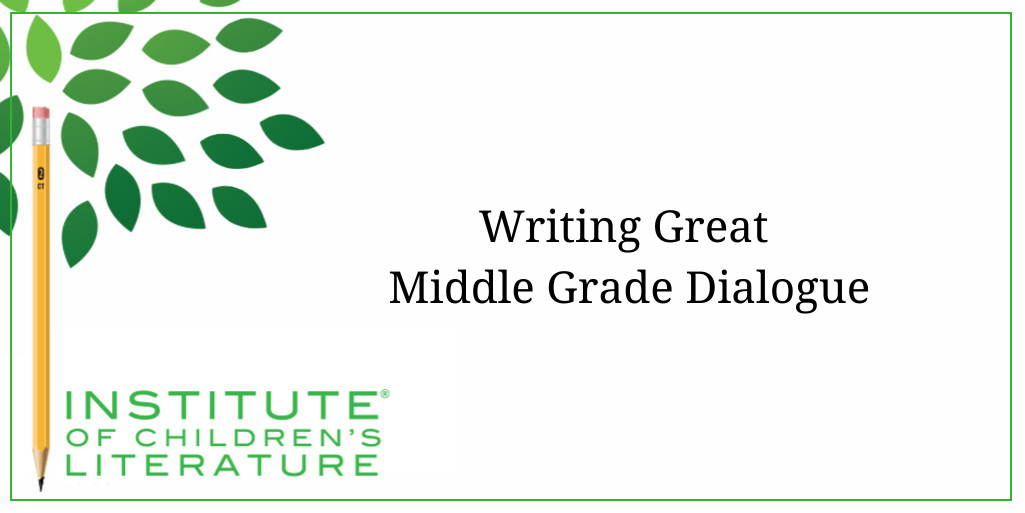
5 Ways Writers Can Prep for 2025 Goal Setting
Before we roll on to the new writing year, let’s harness our optimism for the blank slate before us and prepare for our 2025 Goal Setting just for writers.

We teach our students how to write and get published!
View our Course Catalog >
Dialogue is one of the most important elements at any level of fiction. It strengthens characterization. It helps readers differentiate between characters. It’s helps develop theme, further plot, and build backstory (though each of these uses must be carefully done). Dialogue is a tool to story writing, but it must be used in balance with action (the narrative moments that reveal activity within a scene), transition (the narrative bridge that allows us to jump from scene to scene, to condense time, and to change location), and characterization (the things that make our characters real for the reader). When all the elements work together, a story is engaging and balanced. Because dialogue is an essential element in this balance, it’s worthwhile to take a specific look at middle grade dialogue. So let’s look at some things to consider.
Some time ago, I read a historical fiction manuscript with a large family. The family was large only because this was common for the time period. The children in the story tended to act and speak in a clump, and it was clear that dialogue was handed out fairly randomly to give each child something to do. First it was the first child’s turn, then the second, then the third, then back to the first. The dialogue was written solely with plot in mind. The children were offering the reader exposition to help the reader “catch up” with the setting and time of the story. The children were also giving the father an opportunity to offer his exposition about what he’d encountered in town. But nothing about the dialogue reflected character. It was all there to serve a story purpose and was offered to characters merely to get them all into the scene.

Sometimes it’s fun to create a minor character for a fiction piece who is very chipper: endlessly excited, happy, and talkative. This kind of character produces a lot of dialogue. A character like that can be amusing, and sometimes useful. An extremely chipper character, for example, can be used to hide an important clue in a mystery because the discovery is lost in the barrage of words and excitement from the chipper character.
The problem with creating chipper characters occurs when you fall into the trap of thinking all children act like that. If your “default” for characters under 13 is talkative, hyper, and impulsive, you’re quickly going to end up with characters who babble and confuse the reader. When “chipper” becomes the default, all of your characters will tend to sound alike, making it difficult to tell one from another.
This kind of overly chipper dialogue from all characters tends to come from adults who don’t really know the age group they are writing for very well. As an adult, it’s easy to judge that young people are universally impulsive and talkative, because we can all think of times we were overwhelmed in a conversation with a talkative child. But, in reality, children (like adults) reflect a huge variety of personalities and conversation types. Some children talk a lot because they enjoy the social aspect of connecting through conversation. Some children talk a lot when they are nervous because they haven’t learned how to deal with the discomfort of new situations and relationships. Some children talk a lot in very specific situations but normally are rather quiet. And some children never talk a lot. By making all of your characters chattersome, you lose the nuance of characterization that can come through dialogue. Thus it becomes important to think about your characters complexly if you want to get realistic and enjoyable dialogue from everyone on the page.
Every single person in your story or book needs their own personality. Sometimes you’ll know quite a bit about the person. Your main character and your most frequent secondary characters will all have complex personalities that have been fleshed out well in your mind. But minor characters need to have something of a personality as well. Let’s think about a fairly nondescript character who frequently pops up in stories for this age level: the person who delivers the mail.
An exchange between your main character and the letter carrier could be completely flat on the letter carrier’s part, like this:
As soon as he spotted the blue uniform, Joey thundered out the front door, leaving it hanging wide open as he raced down the steps and across the front yard. He made it to the mail box at the exact same moment as the letter carrier and danced as he waited. The letter carrier pulled a bundle out of the bag on his hip and handed them over to Joey. Joey flipped through the letters, holding his breath. Did it come? It did!
In the above moment, the character of Joey reveals quite a bit about himself, but the letter carrier is a complete blank. Since this is only a single moment in the whole story, it might be fine that the adult in the scene is so unimportant, but in virtually any story, a sliver of personality could come through if you’ll let it and stands the chance of improving the story moment.
As soon as he spotted Mr. Ballard’s blue uniform, Joey thundered out the front door, leaving it hanging wide open as he raced down the steps and across the front yard. He made it to the mail box and danced as he waited to be handed the mail. “You sure you live here?” Mr. Ballard asked in a gruff voice.
Joey wasn’t fooled. He could see the twinkle in the letter carrier’s eyes. “All my life.”
Mr. Ballard laughed. “That long, huh.” He handed over a bundle of mail. “The one for you is on top.”
Joey squealed and raced for the door. Mr. Ballard called after him, “You’re welcome, Joey.”
In this altered exchange, we still get the feeling for Joey’s personality, but we also get a sense of the letter carrier as well. He’s no longer a simple cypher. Instead, he feels like a part of the community of the story. He isn’t a fully fleshed out character by any means, but he’s more than a cutout. And because we allow the character to be more human, the dialogue gives us that nice moment of connection.
One thing to keep in mind in creating good characters for good middle grade dialogue is that people who agree all the time are boring. Even best friends are sometimes very different and have strongly conflicting opinions. For example, suppose I’m writing a mystery story with a group of three friends who are trying to solve the mystery of why the adults in the town are acting so oddly. What kind of kids do I want and what kind of dialogue will result
Observant, intelligent, curious and brave are personality traits that make a good detective. But if I give all three of my characters all the same useful characteristics, they’re going to tend to sound alike, act alike, and bore the reader. They’ll stay on the trail, and they’ll find clues, but they won’t show us anything much beyond simply working the puzzle. But characters with very different personalities can expand a story considerably. So maybe my main character is extremely curious, but possibly also impulsive and overly imaginative. These traits worked together to put her in a situation where she discovered just how weird the adults had become, but she doesn’t have the skills to solve the mystery. She’s going to need help. Help that brings skills to the puzzle that she doesn’t have.
So perhaps, I’ll make one of the characters not at all brave. He avoids social situations because they’re scary, and spends much of his time observing the world from a distance. He loves reading and learning cool facts. Everyone knows this kid is brilliant, but no one really knows him. Still, when the town goes wonky, the main character may think of this super smart kid as a possible ally in figuring out the mystery. But to do that, she’ll have to convince the scared kid to join in. This will create far more interesting dialogue than I’d get from two kids who have the same personality.
My third kid will probably act as a bridge to smooth the bumps between my main character and my scared character. Or maybe not. Maybe I’ll make the third child conflict even harder with the scared child. Maybe this third kid, my main character’s best friend, is so brave that she cannot imagine being scared. And maybe she has the strongest, scariest personality of all, putting her in constant conflict with my brainy, frightened child. In that case, it’s my main character who is constantly smoothing ruffled feathers to the best of her ability.
Ultimately, in a situation like this, the story will do more than simply solve the mystery. It will also show us things about friendship, including making it work, as we watch an unlikely team become friends. One thing that will definitely result is interesting dialogue that sounds very different because it comes from the mouths and personalities of very different children.
Many writers love middle grade dialogue, but it’s important that the dialogue grows out of the story circumstances and the people you’ve populated it with. The better you know the people you create, the better you’ll be able to create scenes where they act and speak in ways that are unique to them. So if you’re having trouble with your middle grade dialogue, or getting negative feedback on your dialogue from those who read your work, look first at your characterization for possible answers. You may find that’s where the answer lies.
With over 100 books in publication, Jan Fields writes both chapter books for children and mystery novels for adults. She’s also known for a variety of experiences teaching writing, from one session SCBWI events to lengthier Highlights Foundation workshops to these blog posts for the Institute of Children’s Literature. As a former ICL instructor, Jan enjoys equipping writers for success in whatever way she can.

Before we roll on to the new writing year, let’s harness our optimism for the blank slate before us and prepare for our 2025 Goal Setting just for writers.

Writers can be thin-skinned when it comes to getting feedback on their work. Let’s look at 4 ways to positively deal with constructive criticism!

Rejection is part of the territory when it comes to being a writer. Today we offer reflection for writers to help redirect your efforts after a rejection.
1000 N. West Street #1200, Wilmington, DE 19801
© 2024 Direct Learning Systems, Inc. All rights reserved.
1000 N. West Street #1200, Wilmington, DE 19801
© 2024 Direct Learning Systems, Inc. All rights reserved.
1000 N. West Street #1200, Wilmington, DE 19801
© 2024 Direct Learning Systems, Inc. All rights reserved.
1000 N. West Street #1200, Wilmington, DE 19801
© 2025 Writewell, LLC. All rights reserved.
1000 N. West Street #1200, Wilmington, DE 19801
©2025 Writewell, LLC. All rights reserved. Privacy Policy.
1 Comment